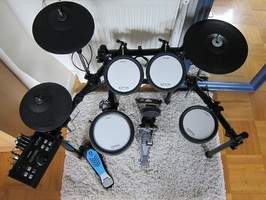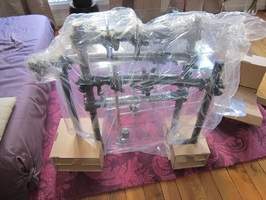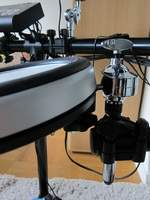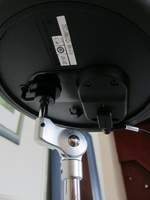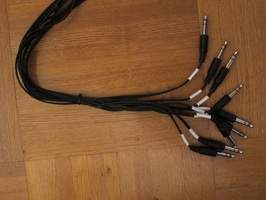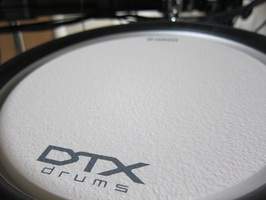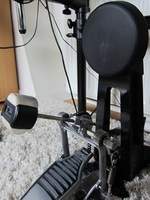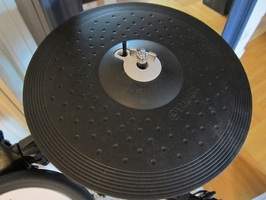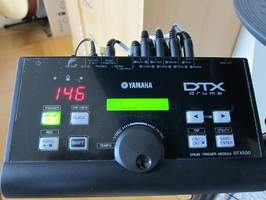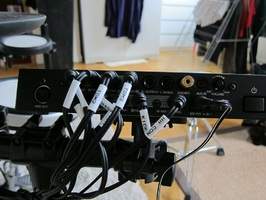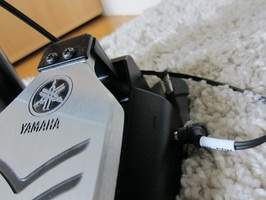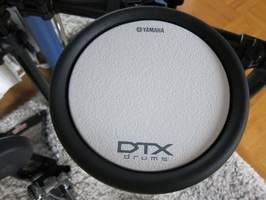Yamaha pulls out all the stops with its revolutionary TCS pads in an attempt to make itself appealing to most drummers who still refuse e-drums. As a DTXPress owner and former user, the DTX540K is reminding me the feelings I had when I first left the acoustic path. Thus, I was very excited and had (too?) high expectations when I started this review. Half satisfied.
The End of a Polemic?
Indeed, Yamaha has been making huge improvements on its e-drum kits for several years and has effectively turn some unsuccessful and unauthentic toys into real instruments. From the very beginning of the e-drums history, the pads have been harshly criticized by many drummers because they were wrist damaging, too small and lagged far behind the performance of acoustic drums.
Yamaha took this very extended discomfort into account and has come back under the spotlight with a new pad generation. As part of the DTX500 series, whose products are based on the same sound module, the DTX540K offers TCS pads (Textured Cellular Silicone) combining silicone and air blisters for toms and snare drum, and 3-zone pads for cymbals, thus offering extended possibilities to drummers. While in the past they were only practice instruments for drummers living in apartments, Yamaha presents now its new e-drum kits as being much more sexy and capable of competing with products of other manufacturers and even with real acoustic drums.
Ultimate Removal Man
Having passed the transportation test — one of drummer’s favorite sports — it’s time for me to unpack the beast. All elements are perfectly well protected in four different cardboard boxes. The box with the RS500 rack is monumental, but after taking it out of its protection cover I was positively surprised to see that it was already assembled. Thus, I immediately forgave the effort required for transportation — and I could vaguely remember the nightmare it was to assemble the rack of my DTXPress. Yamaha has simplified things greatly and assembly is now a breeze: just spread out the two main upright posts of the rack and put the tom supports and the cymbal holders into the right position. All other parts of the product are logically sorted in the three remaining boxes so that assembling is not unpleasant at all.
Die-cast Fixation
Without a doubt, the RS500 rack perfectly fulfills its purpose in terms of ergonomics and stability. When it is fully spread out, the kit has almost the same width as an acoustic drum kit.
The snare pad is attached to the rack with a ball clamp system, like the one used for toms on Yamaha acoustic drums. This is a great advantage because you can set and tilt the snare in the perfect position without any effort. The others drums in the kit don’t use this system, but you can always buy a more expensive model in Yamaha’s range that does (RTX570K). Nevertheless, the tom clamps provided are quite good but less precise.
The cymbal pads are mounted on their stands with a sort of center shaft to avoid them from turning on their own axis and thus prevent them from disconnecting accidentally. Although very clever, I think it’s a minor disadvantage with regard to the natural balancing behavior of a cymbal.
The hi-hat and bass drum pad just need to be placed on the floor. The kick requires the arrester to be quickly assembled with the base.
Once all pads are mounted on the rack, just set up the STX500 sound module. Wiring is easy and quick thanks to the cable bundle. Just like Christmas tree lights with multiple ramifications, the one-piece cable snake allows you to walk around the drum kit and easily connect each element to the sound module. Moreover, each connector is equipped with a ring labeled with the corresponding element, which makes wiring much quicker. This is only a detail but it reveals very valuable if you have to mount/dismount your drum kit periodically. No knotted cables anymore and a valuable gain of time!
I needed a bit more than two hours to set up the whole drum kit without any hurry… and removing the protection covers was what took me more time! An easy and quick setup is a great plus! Once I was sitting in front of the drum kit, I had a nice feeling of comfort and could appreciate the high-quality finish. I can’t wait anymore to start playing and finally see the light.
First Impression
The XP70 tom pads and TCS XP80 snare pad feel impressively authentic. The textured pads give them a very pleasant feel under your fingers and your sticks and recall coated heads. The sound produced when hitting the drums is very low, which is a good thing for drummers playing in their apartment and also for their neighbors. Personally, I find that the rebound of the stick on the XP80 and XP70 is a bit excessive. Suddenly, I’m able to play thirty-second notes without a sweat. Afterwards, going back to an acoustic drum kit was quite hard because all the impressive fills and patterns I mastered easily with the e-drums became suddenly much more difficult… The snare pad has three different zones that allow for a very nuanced playing, close to the feel of a real snare. You can play rimshots, cross stick or only the drumhead. The playing comfort is reinforced by the large-diameter snare (8" instead of 7" for the toms).
The KP65 bass-drum pad seems very promising. Considering its quite elastic rubber membrane, I expected an authentic beater feel but instead I noticed some rather unpleasant vibrations in my right foot, and the pad revealed very rigid and loud. While the acoustic sound was reduced by the TSC pads, the bass-drum pad makes much more noise. The zone where the beater hits the pad is large enough to fit two beaters of a double bass pedal. If you want a more realistic bass drum pad, check out the RTX900 series. Use a thick carpet if you play in your apartment to avoid complaints from your neighbor downstairs!
The HH65 hi-hat controller works well, even if it doesn’t feel hard enough under my foot. For drummers who have never played e-drums, the lack of a bar between the pad and the pedal itself can be perplexing but they will quickly get used to this. Once again, Yamaha offers a full hi-hat starting from the DTX700 series and higher.
When it comes to cymbals, the DTX540K includes two different controllers. The PCY100 and PCY135 pads offer three playing zones each. Used as a crash cymbal, the PCY100 can be hit on the edge, the bell and the surface, which allows for many subtleties. Personally, I find the PCY100 are too small, feel too hard and don’t swing enough when you hit them. And unfortunately you’ll feel this stiffness in your hands. Maybe this negative feel can be explained by the pleasure of playing the RCY135. It is much larger than the PCY100 (13" instead of 10"), has a pleasant behavior when you hit the edge, offers extended space on the top, swings authentically, and provides you with a realistic bell. Comparing the CPY100 and PCY135 mounted on the same kit, the differences are obvious. I installed the PCY135 alternately on the hi-hat and the crash stand: the playing feel is much better, similar to when playing the ride.
When playing the DTX540K unplugged, we have mixed feeling. Some elements reveal very pleasant (TCS pads) while others disturb the playing harmony (bass drum pad and PCY100 cymbals). But it’s time now to turn on the sound module and give life to the instrument.
Modular Statement
The main asset of the DTX500 sound module is its simplicity. Once mounted on the rack, you can access all control elements from the top side except for the volume. In fact, this potentiometer is very small and unpractical. Even though it is one of the controls that you will need to adjust more often, it is hidden on the rear panel next to the output connectors. However, the overall design is almost perfect and the operation is intuitive. The sound module was conceived so that only two fingers are enough to control all available functions. While playing, I was able to use all features without having to let go of the sticks.
Eight buttons are perfectly sorted in two groups of four buttons on the right of the front panel. On the left, you’ll find a selection encoder and a small display divided into two areas. All outputs are placed on the top of the rear panel for quicker access. The metronome has a large BPM display so that you never lose sight of the tempo. The sound module also has L/R and MIDI outputs, an AUX input to play with previously recorded material, and a headphones out. A minor con is that the light plastic housing of the sound module doesn’t seem to be very rugged, so take care not to damage it. The module also allows you to add three tom pads to the drums kit using Y cables in order to connect two mono tom pads to one stereo input. Another mono pad can be connected to the KP65 kick to extend your kit even further. Yamaha built a compatibility chart for the connection of other Yamaha e-drum series (DTXREME, DTXPRESS, DTXPLORER).
Just push the DRUM KIT button to access the 50 drum kits pre-recorded by Yamaha. All music styles are available (rock, metal, electro, Cuban, reggae, jazz and other USO — Unidentified Sound Objects!) You can use these drum kits as the starting point to configure your personal kits (up to 20 custom kits can be stored in the sound module). The sound palette at your disposal is very wide when you consider all editable elements. You can use up to 78 snare elements, 41 bass drums, 50 toms, 46 cymbal elements, and 41 hi-hat elements. Add to this tone and volume controls for each drum, balance control for each element, reverb sustain, level and reverb type (room, stadium, stage, and even tunnel — only Sigur Ros’ pool is missing!), or the “snare effect” corresponding to the size of the snare strainer. A master EQ allows the user to adjust low and high frequencies for each pad. In short, enough to spend hours creating your personal kit, even if the results won’t always satisfy your expectations! For customization kings.
Generally speaking, I find the sound samples are not breathtaking, considering the very high-quality drum samples available on the market. With higher quality samples, the playing comfort and the sound quality could be greatly improved. The cymbals’ choke function seems more like a gimmick or, to put it another way, it goes too far from real choked cymbals. When you damp a pad with your hand the sample is abruptly cut off.

- Exemple 100:50
- Exemple 200:31
- Exemple 300:57
Man at Work!
The metronome is a good companion for a drummer and allows you to control and reinforce your tempo feel. The metronome is fully customizable and you can store click sets in the module. Just press the on/off button to start the metronome. You can adjust the tempo with the center encoder, which is a real gain of time. The Tap tempo function is a great feature. You just have to mark the tempo on a pad and the DTX500 registers it (from 30 to 3000 BPM). This is a huge advantage when you don’t know the tempo of the song you’re playing (I know the situation very well!).
Another amusing feature is the groove check function, whereby the module rates the precision of your beats. The more precise your beat is, the more the difficulty increases: the margin of tolerance with regard to the selected tempo becomes always smaller. If your beat is imprecise, you can even decide to have all notes outside the margin of tolerance muted.
The module includes 63 play-along songs, the tempo of which is adjustable with the encoder. You can also mute the drum part in order to hear only the other instruments of the song. Or for even more efficiency, you can work only with the bass to improve the tightness of the rhythm section. But the songs don’t sound very well and can become boring very quickly.
The DTX500 allows you to record your performances with or without playback. This can be useful to monitor improvements in your playing or to record song ideas. 19 memory locations can be used to store your own work. The quantize function allows you to align the notes to the nearest beat if your playing is a bit off.
Conclusion
To wrap it up, the DTX540K is a mid-range product with some pros and cons. Some elements are just perfect, especially the rack, the XP70, XP80, and PCY135 pads, as well as some features of the module that allow you to practice more efficiently. But the sounds, the PCY100 cymbal pads and the KP65 kick darken the picture a little bit. This results in a wandering between pleasure and frustration that makes you want to look at more expensive drum kits to reduce your dissatisfaction.
The price of the instrument seems a bit too high. But the price certainly has to do with the new-generation pads. For example, the only difference compared to the DTX520K are the XP70 tom pads, which results in a substantial increase in price. The DTX540K is in the same price segment as the TD 9 K2 from Roland — another giant on the e-drums market — whose pads have a different design (meshed heads) and feel. It’s all a matter of taste I guess. The pad war is still raging and there appears to be no end in sight!
Anyway, this Yamaha is a good practice drum set for a wide range of musicians and it offers a good playing comfort in spite of its handicaps. However, it didn’t convince me enough to take it on stage instead of my acoustic drum kit. But who knows what surprises the future will bring…

